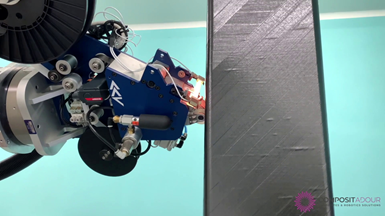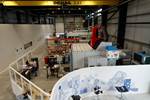AFP-XS platform demonstrates rectangular tube manufacture
Addcomposites collaborated with MBDA and Compositadour to produce lightweight, stiff and weatherproof components that are electrically insulating, chemically resistant and dimensionally stable.
In collaboration with defense manufacturer (Le Plessis-Robinson, France) and the Compositadour (Bayonne, France) team, Addcomposites (Espoo, Finland) recently demonstrated the process for manufacturing rectangular tubes with its AFP-XS platform. The layup program was generated using the winding feature of the company’s AddPath software. As shown in the video above, layup on the sharp radial corners ensured wrinkle/pucker-free layup through sharp steering.

Photo Credit: Addcomposites, Compositadour
What was the reasoning behind manufacturing rectangular tubes? According to Addcomposites, this shape offers several benefits, including aesthetic appeal and high strength-to-weight ratios (compared to other forms of beams). Rectangular tubes are said to also exhibit high load-bearing properties — in both torsional and compression directions — enabling them to be suited to many different applications, as well as optimized environmental resistance, ideal for outdoor applications. Tubes are commonly used as structural elements in buildings, bridges and a wide variety of end-use consumer applications. Additional applications include tool handles, constrained telescopic structures, booms, lightweight housings, sports equipment, robot arms and antenna tubes.
The importance of using the automated fiber placement (AFP) process, says Addcomposites, further reduces wall thickness and weight, while improving stiffness and strength. This is in comparison to conventional winding and pultrusion. Moreover, each part can be optimized according to application requirements, via fiber orientation, localized reinforcements and diameters ranging from 20-1,000 millimeters. The resulting rectangular tube is a lightweight, stiff and weatherproof structure that is electrically insulating, chemically resistant and dimensionally stable.
Related Content
-
McLaren develops aerospace-inspired ART method for volume composite super car engineering
Automated rapid tape (ART) technique, already deployed at the MCTC and to be used for future McLaren models, is capable of producing lighter, stiffer and stronger carbon fiber structures with less waste.
-
Rocket Lab begins installation of large AFP machine for rocket production
The 99-ton AFP machine, custom-designed and built by Electroimpact, is claimed to be the largest of its kind, expecting to save around 150,000 manufacturing hours in the Neutron rocket’s production process.
-
Mikrosam equips BTU Germany with single-tape AFP head for Type 5 pressure vessels
Delivery of upgraded placement head provides additional automated layup flexibility, quality control for the university’s latest projects advancing Type 4 and 5 hydrogen storage.



